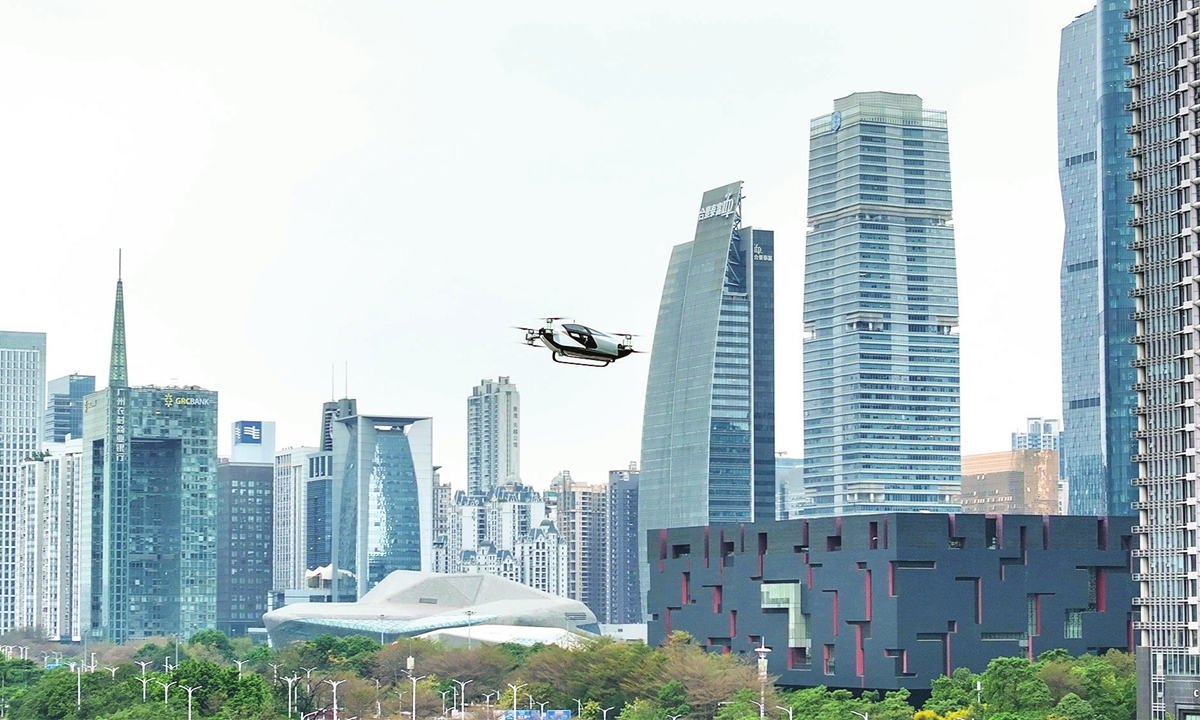Trillion-yuan new industry gears up for ‘takeoff’ as low-altitude economy in China gains momentum

A flying drone car completes its trial flight in Guangzhou, South China's Guangdong Province, on March 8, 2024. Photo: Courtesy of XPENG AEROHT
During the congested morning rush hour, hopping in a "flying taxi" to work, then enjoying a freshly brewed, drone-delivered coffee, and later, in the evening, watching a light show orchestrated by drones are all scenes that would only be possible in science fictions, are now becoming true.
Little known before, the low-altitude sky is growing increasingly busy, setting the stage for the rise of the low-altitude economy and a trillion-yuan market scale, which is gearing up for a "take-off."
Along with bio-manufacturing and commercial spaceflight, the low-altitude economy is included in this year's Government Work Report for the first time as a new growth engine. While 2024 has been considered the inaugural year for the development of this sector, provinces and cities across China have accelerated its layout, aiming to gain a competitive edge in the emerging industry.
The low-altitude economy refers to a comprehensive economic form that develops in the airspace 3,000 meters above the Earth's surface. It is led by various manned and unmanned aerial vehicles' low-altitude flight activities, a service that produces true economic values.
The economy is characterized by a long industrial chain, wide applications, and strong growth potential, with use scenarios including its integration with agriculture, aerial monitoring, firefighting, logistics and more.
Flying drone vehicles
In the central business district in Guangzhou, Guangdong Province, Chinese flying car company XPENG AEROHT recently completed the first low-altitude flight of its drone car XPENG X2, according to a statement the company sent to the Global Times on Wednesday.
It offers valuable insights for the widespread adoption of future urban aerial transportation and low-altitude tourism, among other applications in the low-altitude economy, the company said.
China's leading autonomous aerial vehicle technology platform EHang started to sell its self-developed unmanned electric vertical take-off and landing (eVTOL) aircraft EH216-S on Chinese e-commerce platform Taobao, with its pricing set at 2.39 million yuan ($332,032) per unit.
"Our ultimate goal is to offer new low-altitude travel services to every ordinary citizen. On a national platform like Taobao, we hope to promote the value of the future low-altitude economy to consumers," He Tianxing, a deputy president of EHang, told the Global Times in a statement.
EHang's eVTOL aircraft is capable of providing autonomous logistics solutions and services, covering from long distance inter-city transportation to intra-city cargo deliveries, especially the logistics transportation at mountains and remote areas, according to the company.
In December 2023, the Civil Aviation Administration of China (CAAC) has issued a certificate to the country's independently-developed AS700 civil manned airship.
Developed by the Special Vehicle Research Institute under the Aviation Industry Corporation of China, the manned airship can carry up to 10 people onboard, including the pilot. It has a maximum take-off weight of 4,150 kilograms, a maximum flight range of 700 kilometers, and a maximum endurance of 10 hours.
"As a representative of the new quality productive forces, I believe that the inclusion of the low-altitude economy in the Government Work Report is due to its potential to promote productivity and technological revolution," Du Wei, the person in charge of the AS700 research project, told the Global Times on Sunday.
The low-altitude economy also involves the manufacturing of high-end equipment, low-altitude flight activities, and the construction of supporting infrastructure of airspace. It has a wide application and a long industrial chain, belonging to technology-intensive or technology-innovative industries, which align with the characteristics of new quality productive forces, Du said.
New growth engine
While still in its early stages, the low-altitude economy has become a consensus among the government, industry, and enterprises as a new engine for economic growth.
Approximately 20 provinces and cities across the country have prioritized the development of the low-altitude economy in 2024, leading to implementation of favorable policies and regulations, attractive funding and subsidies, infrastructure support and suitable sites for eVTOL operations, and paving the way for establishing a sustainable low-altitude ecosystem.
EHang entered into a strategic cooperation agreement with the municipal government of Hefei, East China's Anhui Province, in October 2023 for joint development of a low-altitude service ecosystem, which includes a financial support fund of $100 million by the city government.
According to the CAAC, the scale of China's low-altitude economy as of the end of 2023 is estimated at approximately 500 billion yuan, with its market size expected to rise to 2 trillion yuan by 2030.
The development prospects and potential economic scale of the low-altitude economy may be broader than we initially anticipated. It has the potential to fundamentally transform transportation and logistics, Wang Yanan, chief editor of Beijing-based Aerospace Knowledge magazine, told the Global Times on Tuesday.
Moreover, the new sector could significantly enhance the efficiency of societal operations, Wang noted.
Within the scope of the low-altitude economy, aircraft may transition from being primarily large-scale public transportation tools to becoming community oriented, and even possessing a certain degree of individualized customization. This transformation would have considerable implications for both the industry and the societal impact, Wang said.
The reason why many countries around the world are focusing on developing this new sector is because it could herald a new industrial transformation, he said, adding that China has established a technological edge in this field and is better positioned in the industry's future development. "It is crucial to accelerate development and seize the development initiative," Wang noted.
China is expected to account for about 25 to 30 percent of the global eVTOL market in 2030, Xinhua News Agency reported, citing an industry report.
As of the end of 2023, the number of general aviation firms in China stood at 689, with 3,173 general aviation aircraft registered and 451 general aviation airports set up, Xinhua reported.
Photos
Related Stories
- China's fiscal revenue down 2.3 pct in first two months of 2024
- China's financial institutions report 9.9 pct growth in assets
- China identifies 15,000 projects to be backed by 1-trillion-yuan bond issuance
- Nation opens up wider to foreign investors
- China has vast space, outstanding advantages to attract foreign investment in long run: top economic planner
- China seeks win-win for economic growth, carbon reduction
Copyright © 2024 People's Daily Online. All Rights Reserved.









